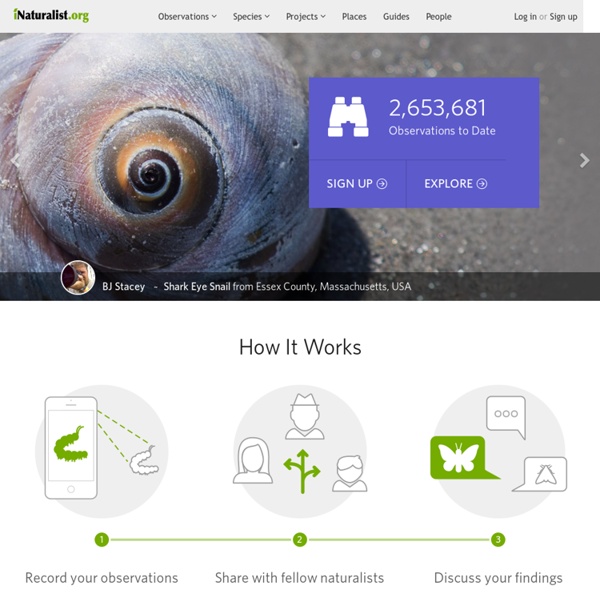



Volunteers Needed for Massive Smithsonian Digitization Project Today the Smithsonian launches its Transcription Center website to the public. The website is designed to leverage the power of crowds to help the Smithsonian unlock the content inside thousands of digitized images of documents, such as handwritten Civil War journals, personal letters from famous artists, 100-year-old botany specimen labels and examples of early American currency. The Smithsonian has already produced digital images for millions of objects, specimens and documents in its collection. Many of the digitized documents are handwritten or have text that computers cannot easily decipher. Transcription by humans is the only way to make the text of these items searchable, which will open them up for endless opportunities for research and discovery.
Energy conservation teaching resources, elementary and high schools - EarthCARE Canada Quebec Canadian Montreal Research and Academia : Valarm KML exported directly from Valarm instantly produces compelling 3D visualizations using Google Earth. A powerful research and data collection tool since it integrates a variety of sensors: temperature, humidity, CO2, VOCs, switches, potentiometers, and electrical resistance. Sensors built in to mobile devices are also supported: GPS, accelerometer, light sensor, microphone, camera, 3G/4G, WiFi. Valarm provides functionality for real-time data collection purposes in urban and rural environments. ictmagic.wikispaces guest | Join | Help | Sign In Add My Button to your Site Click the Button Add my widget to your site Click </> button above <a href=" Live Blog Stats</a>
Notes from Nature People have been collecting specimens from the natural world for centuries - minerals, plants, fungi and animals. Today, there are an estimated two billion specimens housed in natural history museums around the world! These biological collections document where species and populations exist now and where they existed decades and centuries before, so they hold irreplaceable information necessary for uncovering the patterns of changes in species distributions and ecosystem composition over time. Scientists use such data and information in order to address key environmental issues we are facing right now, such as the impacts of climate change and how diseases affect wildlife and humans. For the information held in these collections to be used to its full potential there must be better digital access to these data.
Medical Animation Library ©Copyright 2009 A.D.A.M., Inc. Any duplication or distribution of the information contained herein is strictly prohibited. The information provided herein should not be used during any medical emergency or for the diagnosis or treatment of any medical condition. A licensed physician should be consulted for diagnosis and treatment of any and all medical conditions. Scientific Communication What information should you include in an abstract, and in what order? How can you get your message across in an oral presentation — with or without slides? How much text is acceptable on a poster? Communication is an integral part of the research you perform as a scientist and a crucial competence for a successful career, yet it is an activity you may not feel prepared for.
Experiment 1: Acidity - iyc Acidity Students will use colorful indicators, either from their school’s supplies, or from the resource kit, to measure the pH of their local body of water. They will be learning about acidity, one of the most common chemical properties encountered around the home. NSF Citizen Science DiscoveryBe a (citizen) scientist! A celebration of open science and innovation September 30, 2015 So you want to be a citizen scientist? Lawrence Hall of Science - 24/7 Science How fast does the wind blow? What makes things sticky? Where do insects live and plants grow? What is the best way to clean up the environment? How do humans measure up in the animal kingdom? So many questions—and so many ways to find answers!
Video Introduction to Bayesian Data Analysis, Part 1: What is Bayes? This is video one of a three part introduction to Bayesian data analysis aimed at you who isn’t necessarily that well-versed in probability theory but that do know a little bit of programming. I gave a version of this tutorial at the UseR 2015 conference, but I didn’t get around doing a screencast of it. Until now, that is! Notes from Nature Natural History has its roots in the ancient world, from Aristotle’s History of Animals to Pliny the Elder’s Natural History. Collection of specimens for “Cabinets of Curiosities” flourished during the Renaissance (many of them contained fantastical faked creatures) and some of the earliest Natural History museums, like the Muséum National d’Histoire Naturelle, were founded. By the 19th century, modern scientific collection had begun and many of today’s Natural History collections originate from this period. At present, there are an estimated 2 billion (yes, really billion) specimens housed in Natural History museums around the world – a truly astonishing record of life on earth.